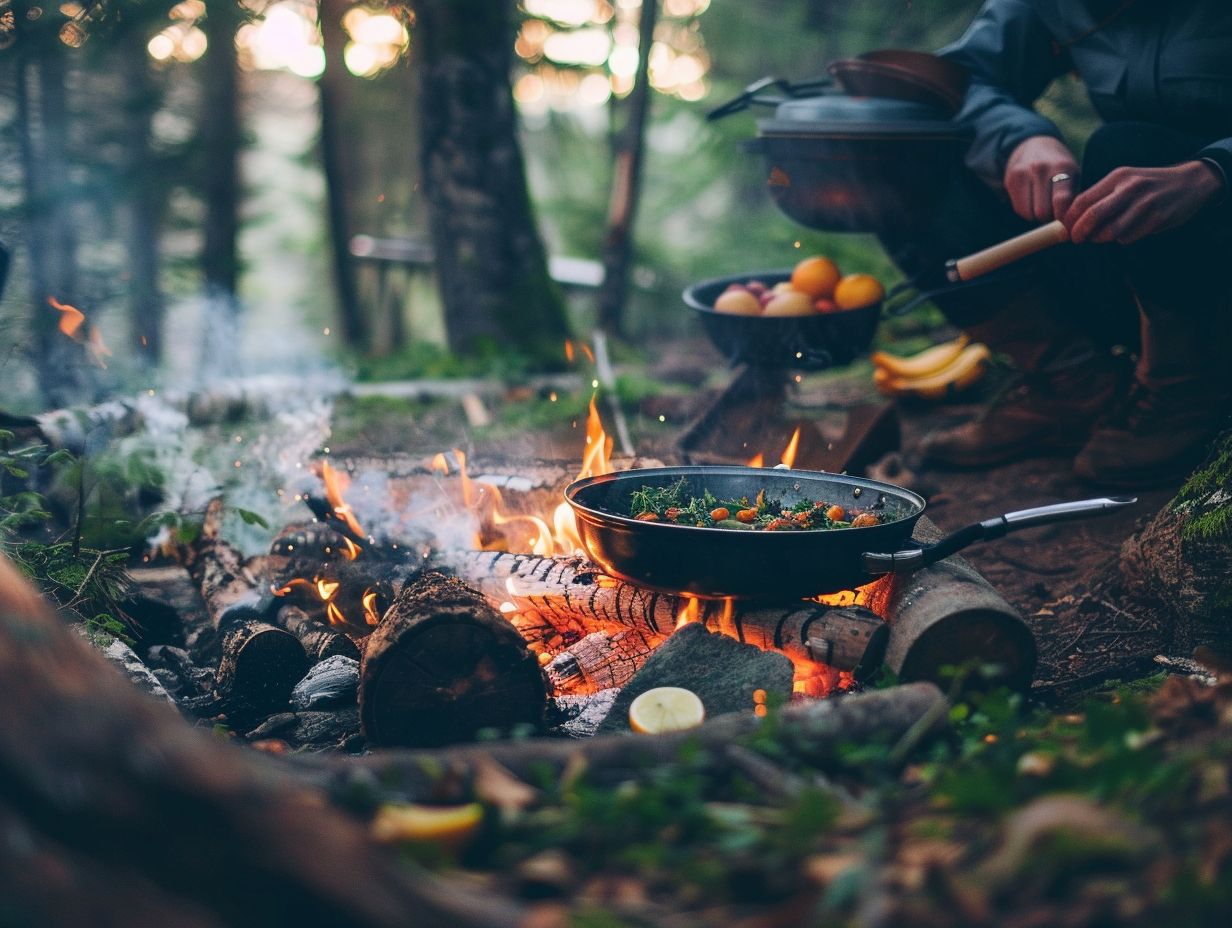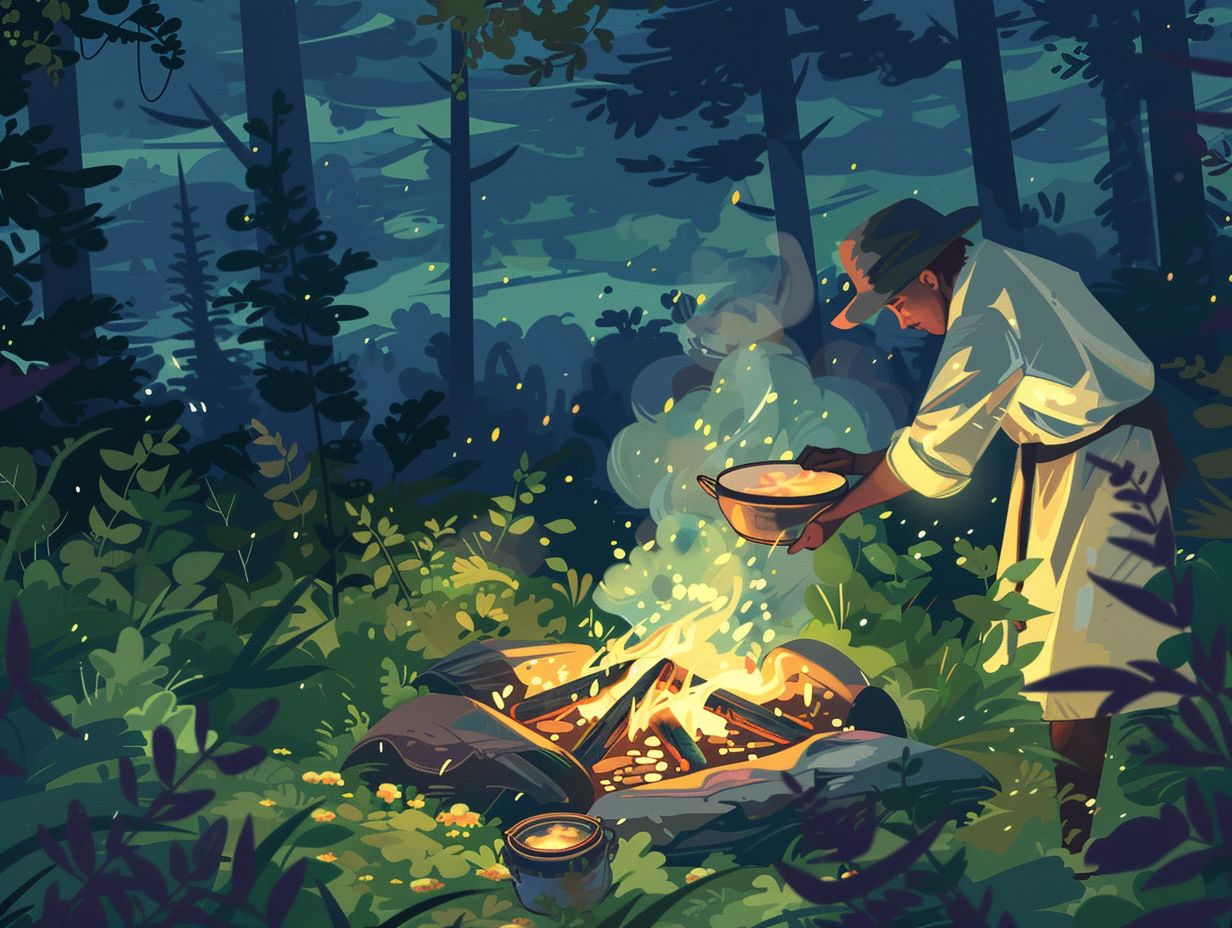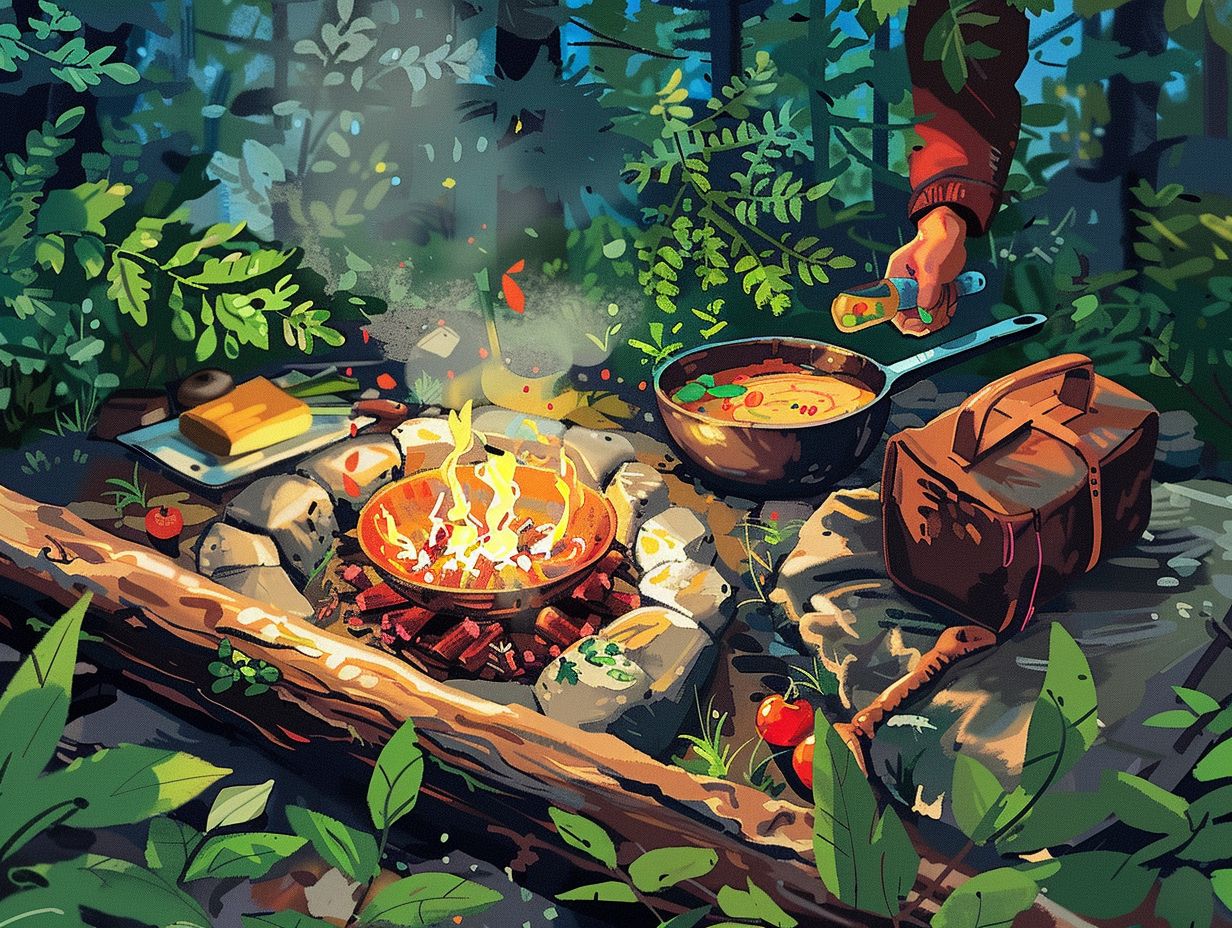Are you tired of the same old camping meals of hot dogs and canned beans? This article will show you how to plan and prepare delicious and satisfying camping meals that will elevate your outdoor dining experience.
From tips on how many meals to plan and what types to include, to ideas for easy and tasty recipes like one-pot pasta and grilled fajitas, you’ll be a camping meal pro in no time.
Get ready to learn how to cook over a campfire, make cleanup a breeze, and keep your meals nutritious and delicious.
Key Takeaways:

- Plan ahead and consider the number of meals needed, types of meals, and dietary restrictions for a successful camping meal plan.
- Prep ingredients in advance and properly pack and store meals to make cooking and cleanup easier while camping.
- Get creative with easy and delicious camping meal ideas, cook over a campfire, and make meals more nutritious for a well-rounded camping experience.
Planning Your Camping Meals
Careful consideration of your camping meals is a crucial component of a prosperous backpacking excursion, ensuring that you have appropriate nourishment to sustain your energy, well-being, and contentment throughout the course of your journey.
How Many Meals Do You Need?
Determining the necessary number of meals for a camping trip depends on the trip’s duration and the expected level of physical exertion each day.
For a short weekend getaway, it may be enough to plan for three meals – breakfast, lunch, and dinner – per day. On the other hand, longer trips or those involving demanding activities such as hillwalking or canoeing may require additional snacks to maintain energy levels throughout the day.
Nuts and seeds, and dried fruits that provide sustenance for outdoor activities. It is important to calculate the required amount based on the duration of the trip and the anticipated activity level to ensure a sufficient food supply for the entire camping adventure.
What Types of Meals Should You Plan?
In the context of meal planning, it is advisable to consider incorporating a diverse range of recipes that are both convenient to prepare and transport, encompassing homemade alternatives that offer a combination of vegetables and protein.
On occasions when time constraints are prevalent, individuals may wish to explore readily available pre-prepared options, such as salads featuring grilled chicken or vegetable stir-fries. These selections can contribute to sustaining a balanced dietary intake even amidst a hectic schedule.
By combining homemade dishes with commercially prepared items, one can ensure a comprehensive offering of nutrients and flavours within their meals. It is important to bear in mind that a well-rounded diet, enriched with vegetables and protein, plays a pivotal role in maintaining overall health and vitality.
How to Account for Special Dietary Needs?
Taking special dietary needs into account involves strategically planning meals to accommodate any restrictions, such as gluten-free, vegetarian, or vegan diets.
When customising backpacking meals to align with dietary restrictions, incorporating versatile ingredients like quinoa, lentils, and tofu can prove to be excellent choices. Quinoa, being a complete protein source, lends itself well to salads or serves as a nutritious base for stir-fries.
Lentils, renowned for their high protein and fiber content, are a satisfying option for soups or stews. Tofu, a plant-based protein alternative, can be expertly marinated and grilled to enhance the flavor profile of wraps or sandwiches.
By experimenting with diverse cooking techniques and flavor blends, one can craft delectable meals that cater to a spectrum of dietary requirements while ensuring the provision of essential nutrients for sustaining energy levels during backpacking expeditions.
Tips for Preparing and Packing Camping Meals
Effectively preparing and packing camping meals can have a significant impact on the convenience and enjoyment of your hiking experience.
Prepping Ingredients in Advance

Preparing ingredients in advance, such as utilising a dehydrator for fruits and vegetables, offers the dual benefits of time efficiency and reduced weight during outdoor activities. Dehydrating food items prior to departure not only facilitates customisation of meals according to individual preferences but also guarantees their freedom from additives and preservatives.
Proactively processing grains and vegetables enables expedited meal preparation, particularly when energy levels are depleted after prolonged outdoor excursions. The dehydration of ingredients like grains and vegetables serves to prolong their shelf life, rendering them suitable for extended journeys or emergency food rations.
Moreover, the lightweight and compact characteristics of dehydrated foods make them particularly convenient for backpackers and campers seeking to minimise their load without compromising on nutritional value.
Properly Storing and Packing Meals
The proper storage and packing of meals necessitate the utilisation of tools such as a vacuum sealer to preserve food freshness and promote organisation.
Efficient packing of food items is imperative to uphold their quality and prolong their shelf life. The implementation of appropriate storage techniques serves to mitigate the risk of meal spoilage and avert potential health hazards.
Regarding on-the-go snacks, the preparation and packaging of do-it-yourself selections like homemade trail mix or roasted nuts present a convenient and nutritious alternative.
These snack options are uncomplicated to assemble and can be compactly packed in portable containers, ensuring swift access during hectic schedules. This meticulous approach to packing guarantees the availability of wholesome snack choices wherever one’s daily activities may lead.
How to Keep Food Cold on Your Camping Trip
It is essential to maintain proper food safety protocols whilst camping, which includes keeping food cold throughout the trip. This can be effectively managed by utilising a cooler along with ice packs.
When selecting a cooler, it is advisable to take into account the duration of the trip and the quantity of food that needs to be stored. Opting for a well-constructed cooler with ample insulation is recommended as it enhances temperature retention capabilities.
To optimise cooling efficiency, it is beneficial to pre-chill both the cooler and its contents before packing. This pre-chilling process aids in sustaining colder temperatures for extended periods. Additionally, employing a combination of ice packs and ice cubes can further prolong the cooling duration.
Strategic organisation of the cooler is crucial. Placing items requiring the lowest temperatures at the bottom and those tolerant of higher temperatures on top is advisable. Regularly monitoring the ice packs’ condition and replacing them as necessary is essential to prevent food spoilage.
Easy and Delicious Camping Meal Ideas
To ensure a successful camping trip, having a variety of simple yet delicious meal choices can significantly improve the overall enjoyment of one’s outdoor adventure.
One-Pot Pasta with Sausage and Veggies
The preparation of one-pot pasta with sausage and vegetables is a convenient and satisfying option for a camping meal. To begin the creation of this delightful dish, one should first fry the sausage in a large pot until it achieves a browned appearance.
Subsequently, the addition of diced vegetables such as bell peppers, onions, and courgettes introduces a vibrant blend of colors and flavors. Following this, the inclusion of preferred pasta varieties, such as penne or fusilli, is recommended for optimal results.
The addition of tomato sauce enhances the dish with a rich and savory base. Allowing the components to simmer together facilitates the thorough cooking of the pasta while enabling the flavors to harmonize.
The inherent simplicity of this one-pot preparation not only offers convenience but also delivers a nostalgic and comforting culinary experience amidst the backdrop of the camping environment.
Campfire Quesadillas
Campfire quesadillas represent a versatile and delicious choice for camping meals, offering the opportunity to personalise them with ingredients such as cheese, vegetables, and chicken. To prepare these savoury offerings over a campfire, the process begins with the assembly of the necessary ingredients.
When selecting fillings, one may opt for grated cheddar, chopped bell peppers, sliced onions, and cooked chicken.
Start by placing a tortilla flat and sprinkling cheese on one half, followed by the addition of the desired fillings. Fold the tortilla in half to encase the ingredients fully. Subsequently, wrap the quesadilla in aluminium foil, ensuring a tight seal.
Position the wrapped quesadilla on a grill above the campfire and allow it to cook for a few minutes on each side until the cheese has melted, and the tortilla has achieved a crispy texture. Enjoy the delightful flavours of your campfire quesadillas.
Grilled Foil Packet Fajitas

Grilled foil packet fajitas represent a convenient and flavoursome meal option suitable for camping expeditions, seamlessly blending chicken and assorted vegetables.
The preparation procedure for these delicious fajitas entails marinating the chicken strips with a harmonious infusion of spices, lime juice, and thinly sliced peppers and onions.
Following the marination process, the components are meticulously arranged on a substantial sheet of aluminium foil, thereby establishing individualised serving packets. These foil packets serve the dual purpose of encapsulating all the intricate flavours while also facilitating an easy cleaning process.
The packets are then placed on the barbecue, allowing the fajitas to undergo optimal cooking, thus filling the campsite with a delightful savoury essence. This simple yet satisfying camping meal is bound to leave a lasting impression on all those participating in the culinary adventure.
Overnight Oats with Fresh Fruit
Overnight oats with fresh fruit represent a straightforward and nourishing breakfast option ideally suited for camping. The process of preparing overnight oats involves combining rolled oats with a selected choice of milk or yogurt within a container or jar, subsequently refrigerating them throughout the night.
Upon awakening, one may introduce an assortment of fresh fruits such as berries, bananas, or sliced apples to personalise the oats with inherent sweetness and additional nutrients. For a touch of tropical essence, the inclusion of desiccated coconut into the mixture may be considered to add an extra layer of flavor and consistency.
These additional components not only enhance the taste profile but also enhance the overall nutritional value of the breakfast, making it a satisfying and healthy meal to start one’s day.
Additional Tips and Tricks for Making Camping Meals
Additional suggestions and techniques can enhance the overall enjoyment of your camping meals, ranging from preparing food over a campfire to streamlining clean-up processes and ensuring the nutritional value of your meals.
How to Cook Over a Campfire
Cooking over a campfire necessitates a fundamental understanding of fire safety protocols and culinary techniques to ensure the proper preparation of food.
When engaging in campfire cooking, it is imperative to assess the nature of the food being prepared in order to ascertain the most suitable method. For meats such as hot dogs and sausages, the preferred approach often involves utilising a roasting stick to achieve uniform cooking over the flames.
Conversely, vegetables can be encased in foil along with seasonings to create a delightful and uncomplicated side dish. Prioritising safety is paramount during the handling of food over an open flame; thus, it is essential to have a readily available water source and refrain from leaving the fire unattended.
Ways to Make Cleanup Easier
Ensuring efficient clean-up procedures following camping meals can enhance the overall enjoyment of the trip by saving time and reducing effort expended.
A method to optimise the clean-up process involves utilising a limited number of utensils during meal preparation and cooking. Selecting one-pot recipes or dishes that can be cooked directly over the campfire minimises the quantity of dishes necessitating washing.
Meal options that entail minimal preparation and clean-up, such as sandwiches or wraps, significantly diminish the time allocated to post-meal clean-up activities. By employing a strategic approach towards meal selection and cooking techniques, individuals can allocate more time towards relaxation amidst natural surroundings and less time towards dishwashing.
How to Make Meals More Nutritious
Enhancing the nutritional value of camping meals requires the incorporation of a diverse range of ingredients that are rich in essential vitamins, minerals, and protein.
To achieve this objective, it is recommended to include a combination of fresh fruits and vegetables, whole grains, lean proteins, and healthy fats in the camping menu. Strategic meal planning in advance is essential to ensure the intake of necessary nutrients for sustained energy levels during outdoor activities.
Opting for easily portable items that require minimal cooking, such as nuts and seeds, dried fruits, canned beans, and wholemeal crackers, can streamline the meal preparation process. Furthermore, the addition of herbs and spices can enhance the taste profile of dishes without relying on excessive salt or unhealthy additives.
Frequently Asked Questions

What are some easy-to-make camping meals?
Some easy-to-make camping meals include sandwiches, foil packet meals, and instant noodles. These meals require minimal preparation and cooking time, making them perfect for camping trips.
What cooking equipment do I need for making camping meals?
The essential cooking equipment for making camping meals includes a portable stove, a pot or pan, utensils, and a cooler for storing perishable ingredients. Depending on the meals you plan to make, you may also need a grill, a griddle, or a Dutch oven.
How do I plan for camping meals?
To plan for camping meals, start by making a list of all the meals and snacks you will need. Consider the number of people and the length of your camping trip. Then, create a meal schedule and a grocery list. Be sure to include non-perishable options and plan for meals that can be easily cooked over a campfire.
Can I make healthy camping meals?
Yes, you can make healthy camping meals. Some options include grilled vegetables, salads, and fruit salads. You can also opt for lean proteins like fish or chicken and whole grains like quinoa or brown rice. Just make sure to pack and store these ingredients properly to keep them fresh.
Can I make vegetarian or vegan camping meals?
Yes, you can make vegetarian or vegan camping meals. There are many plant-based options that are easy to prepare and cook while camping. Some ideas include veggie skewers, bean burritos, and tofu stir fry. You can also bring pre-made vegan alternatives like veggie burgers or vegan hot dogs.
What are some tips for cooking and storing food while camping?
Some tips for cooking and storing food while camping include packing ingredients in sealed containers or ziplock bags to prevent them from getting wet or spoiled. Invest in a good cooler and keep it in a shaded area to keep food fresh. When cooking, be sure to follow food safety guidelines and properly clean and store all cooking equipment.

